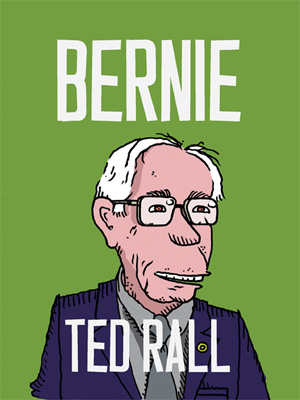
A few months ago, Senator Hillary Clinton looked like a sure bet to earn the Democratic party nomination to run for President.
Over the past twenty years, she has constructed a mainstream political resume and secured corporate backing that could help her succeed against the Republicans’ money-driven incitement of America’s paranoid side.
Senator Bernie Sanders–a man in his seventies who has ignited the imagination of many young people–is poking holes in the aura of inevitability that surrounds Clinton. Who is this man who identifies as being a democratic socialist, who came close to winning the Iowa caucus and thumped Clinton in New Hampshire’s primary this week?
Political cartoonist Ted Rall provides some answers in Bernie, his fine graphic nonfiction book about the veteran politician from Vermont. He offers a deftly drawn, incisive portrait of the man and the political climate against which he rebels.
Rall, whose most recent book is Snowden, smartly combines the biography with an exploration of how a powerful Southern-led faction of the Democratic leadership dumped liberalism after Nixon’s landslide victory over McGovern in 1972.
Sanders, a scrappy ex-jock who grew up in Brooklyn, aligned himself with progressive causes from college onward, from civil rights, to LGBT equality, the anti-war movement, and women’s liberation.
But as he entered politics in the early ’70s, the Democratic Party began its decades-long recanting of liberalism’s first principles of economic opportunity combined with social justice. White flight from the feared browning of their neighborhoods found a political counterpart in the abandonment of the Democratic party by white Southerners.
Fearful of losing their grip on power, conservatives within the party began promoting centrist candidates. Along the way, the leadership squashed liberal and leftist dissent, arguing that the Presidency could only be won by attracting voters from the vast white middle of the electorate.
Bernie wasn’t having that. Starting with his terms as mayor of Burlington, Vermont, he proudly called himself a socialist. Entering Congress in the 1990s, he often caucuses with Democrats but breaks from them on issues relating to racial and income inequality.
That rebellion against the status quo may be one reason why Sanders holds such appeal for younger voters.
Writes Rall, “Recent college graduates emerge into a bleak job market, staggering under the burden of student loans they’ll never be able to repay. Because Congress has rewritten bankruptcy laws in favor of the banks, those debts are permanent and can never be discharged.”
Their blue collar peers face similar problems with stagnant wages and a perpetual war economy that builds bombs instead of daycare centers.
While largely approving of Sanders record, Rall does describe the antiwar left’s criticism of Mr. Sanders’s unwavering support for Israel and President Obama’s targeted assassination of suspected terrorists.
There is debate as well among leftists over Sanders decision to run as a Democrat and over whether they can support a Euro-step candidate who seems to be more inspired by Nordic nations than by classic Marxist-Leninist (or Maoist) doctrine.
With a system so stacked against socio-economic change, why even run? In a recent campaign speech, Sanders said bluntly that no person elected to the presidency will “be able to address the enormous problems facing the working families of our country. They will not be able to succeed because the power of corporate America, the power of Wall Street, the power of campaign donors is so great that no president alone can stand up to them.”
As laid out in Rall’s book, Sanders’ goal is to help spur the American people to organize for change and not rely on one person or one party to make that happen.
Bernie delivers both a quick read and a lasting impression.










